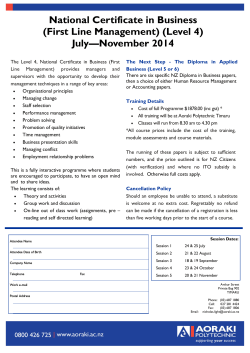
Tilslutningsdiagram Animeo Solo MoCo relæ
Jacob Primault, Master in Econ. Certified PRINCE2 and MSP Manager, Rambøll Management Consulting Expert in project- and programme management, benefit management, governance and organizational development jacp@ramboll.com Cell Phone: +45 51618247 DET DANSKE SIGNALSYSTEM MÅ UDSKIFTES • Gammelt signal udstyr • Faldende regularitet pga. signalanlæg • Svært at interface mellem forskellige teknologier • Unikt dansk signal og operationelle regler • Monopol marked situation – høje adgangsbarrierer • Høje vedligeholds omkostninger • Mangel på menneskelige ressourcer, som forstår de gamle systemer 2 OVERORDNET TIDSPLAN Phases Fjernbane and S-bane 2009 Fjernbane 2021 S-bane 2018 2010 2011 Procurement (2.5 years) Procurement (2 years) 2012 2013 2014 Design (3 years) Design (2 years) Test (1.5 years) 2015 2016 2017 Test (3 years) 2018 2019 2020 2021 2022 Roll-out (4 years) Roll-out (4 years) 3 FRAMEWORK AND FOUNDATION PROGRAMME OVERVIEW 5 HIGH LEVEL APPROACH TO PROGRAMME MANAGEMENT Time Deliverable Temporary organisation Base organisation Price Quality Benefit realisation CHANGES TRANFORMATIONAL FLOW BENEFIT REALISATION BUSINESS CHANGES PROJECT DELIVERABLES BENEFIT PROFILES BLUEPRINT VISION DRIVER BENEFIT PROFILES: DEFINITION AND SPECIFICATION ”A Benefit is an outcome of change which is perceived as positive by a stakeholder” ”Benefit Realisation Management is the process of organising and managing, so that potential benefits, arising from investment in change, are actually achieved” POTIC The approach for the development of BDM is based on the POTIC model. The model covers five areas which are considered essential if the benefits of the Signalling Programme are to be achieved: The approach for the development is based on the POTIC model: model covers fiveprocesses, areas which are considered essential and which •The Processes: Working workflows, procedures and interfaces between units. must change if the benefits from the Signalling Programme are to be achieved. The five areas can be described as follows: • Organisation: Organisational structure, roles and responsibilities, skills, management, strategies, politics and organisational relationships. Processes: Working workflows, procedures and • Technology: It-systems andprocesses, tools, equipment, building, accommodation requirements, quality interfaces betweensystems. units. systems, communication Organisation: Organisational structure, roles and • Information: Instructions, information and data requirements and flow of responsibilities, skills,documentation, management and organisational information relationships. . Technology: It systems tools, equipment, buildings, • Culture: Organisational culture, and style, personnel and working approac h. accommodation requirements, quality systems, communications systems. Information: Instructions, documentation, information and data requirements and flow of information. BLUEPRINT
© Copyright 2025











